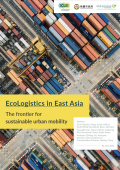
This study looks at how EU initiatives, like the Circular Economy Act and the New European Bauhaus, are leading the way in circular solutions.

This factsheet illustrates how the Argentinian construction industry is actively lowering GHG emissions by incorporating a material efficiency strategy within its regulatory framework.

This case study helps to understand the sectoral approach of inventories for persistent organic pollutants and the benefits of dynamic material and substance flow analysis in assessing POPs in the building and construction sector.

The case study details the use of the SOURCE platform to strengthen Ukraine's capacity for sustainable infrastructure.

The case study details the Samuel De Champlain Bridge Corridor Project which received the Envision Platinum Award for its Sustainability Performance.

The case study details Japan's adoption of Ecosystem-based Disaster Risk Reduction to replace its ageing infrastructure.
The research presented in this study is aimed to identify best practices on adopting, implementing and enforcing energy efficiency standards and energy efficiency technologies for the building sector in the UNECE region.

This paper presents case studies and analysis of the mobility and logistics challenges of three East Asian cities.
This case study is based on the findings from the assessment of the Greater Banjul Project 2040. With the help of the Capacity Assessment Tool for Infrastructure (CAT-I), researchers identified the potential barriers to the planning, delivery, and management of sustainable infrastructure projects faced by the Gambian government. This study illustrates the first of the ten International Good Principles of Sustainable Infrastructure: Strategic Planning.

This paper provides an understanding of how COVID-19 has impacted sustainable transport modes and examples of how governments are using this moment to leverage the increase in different forms of sustainable mobility.
